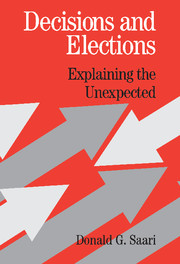8 - Glossary, Notes, and Technical Talk
Published online by Cambridge University Press: 21 May 2010
Summary
To assist the reader, certain basic terms and results often used in the discussion are catalogued here. This is followed with brief notes and references to help the interested reader to further investigate these topics. Rather than providing a complete listing of relevant references, my intent is to suggest places to start. Finally, comments about axiomatics and a technical, geometric proof of Arrow's Theorem are given. This proof is designed to emphasize how binary independence loses information about voters and allows nonexistent irrational voters to influence the procedure's outcome.
Glossary
Anscombe Paradox. (Page 123.) A profile example showing that, by pairwise voting, a majority of the voters can be on the losing side on a majority of the issues.
Arrow's Theorem. (Page 43.) This assertion is responsible for inspiring much of the research activity about voting and decision processes over the last half century. It requires the voters to have strict (i.e., no indifference) transitive preferences; there are no restrictions on how each voter ranks the alternatives. The societal outcomes are to be transitive. The only restrictions imposed on the decision procedure is that it satisfies the Pareto and the Binary Independence Conditions. The conclusion is that with three or more alternatives, the only possible procedure is a dictatorship.
Binary independence. (Page 39.) Procedures satisfy this condition if the societal rankings they produce for each pair depends strictly on each voter's relative ranking of the pair; the procedure does not use any information about the other alternatives.
- Type
- Chapter
- Information
- Decisions and ElectionsExplaining the Unexpected, pp. 205 - 228Publisher: Cambridge University PressPrint publication year: 2001



